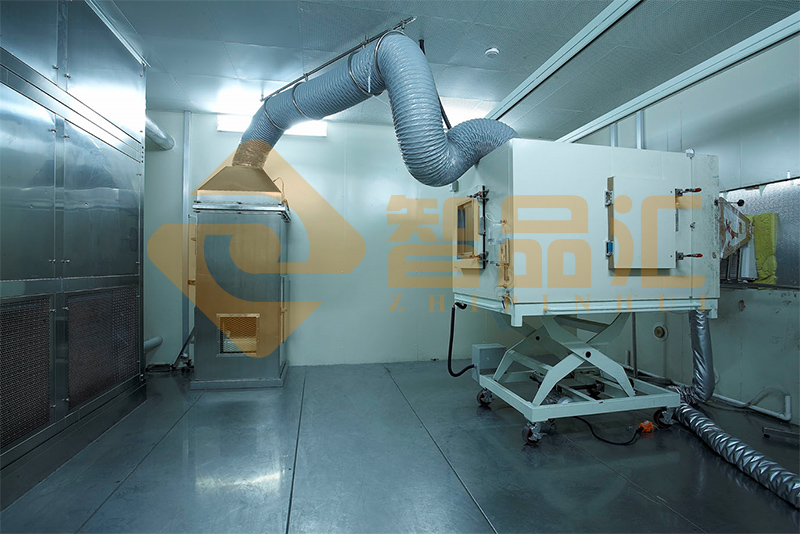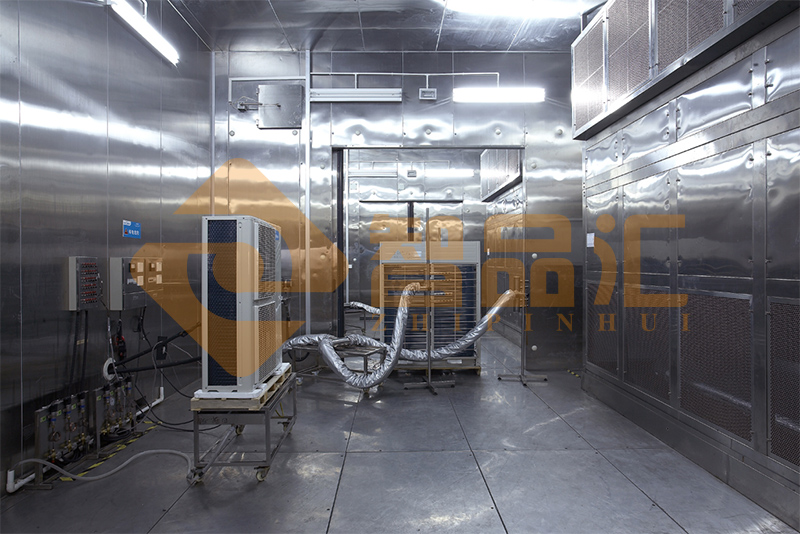 400-816-6687
400-816-6687Air conditioning enthalpy difference method laboratory
1. Overview:
This test room uses the air enthalpy difference method to measure the cooling capacity, heating capacity, low-temperature non-steady-state heating capacity, power consumption, C.O.P., circulation air volume and seasonal energy consumption efficiency of room air conditioners. It can be used as an important means of detection equipment and design and development of room air conditioners. The test room conditions meet the requirements of standards GB/T 7725-2004 and JIS B 8615-1.
This test room includes two rooms (indoor and outdoor), each of which is equipped with an air handling unit to control the air state in each room. In addition, the indoor side contains a set of air volume measurement devices for measuring the air volume and outlet enthalpy of the machine under test. The air volume measurement device includes a static pressure box, a receiving room, a nozzle and an induced draft fan.
The measurement method is to install the air conditioner under test in the actual way, and by controlling the dry-bulb and wet-bulb temperatures on the indoor and outdoor sides of the machine under test, measure the temperature, humidity and air volume of the inlet and outlet air of the indoor unit, so as to calculate the cooling and heating capacity.
This laboratory can be expanded into a one-to-three enthalpy difference laboratory (consisting of four constant temperature chambers), which can carry out tests on one set of one-to-three air conditioners, or independently and simultaneously carry out tests on two sets of one-to-one air conditioners.
II. Technical parameters
Test items
1. Rated cooling capacity test
2. Rated heating capacity test
3. Maximum operation cooling test
4. Minimum operation cooling test
5. Maximum operation heating test
6. Minimum operation heating test
7. Freezing test
8. Condensation test
9. Condensate removal test
10. Automatic defrosting test
3. Technical specifications (the following specifications are for reference only and can also be customized according to user requirements)
1. Indoor dry bulb temperature range: 15 ~ 45 ℃
2. Indoor relative humidity range: 30 ~ 85% RH
3. Outdoor dry bulb temperature range: -15 ~ 55 ℃
4. Outdoor relative humidity range: 30 ~ 90% RH
5. Cooling capacity test range: 2.0 ~ 15 kW
6. Heating capacity test range: 2.0 ~ 16 kW
7. Air volume measurement range of indoor unit of test air conditioner: 4 ~ 40 m3/min
8. Dry bulb temperature control accuracy: ±0.2 ℃
9. Wet bulb temperature control accuracy: ±0.2 ℃
10. Repeatability accuracy: ±1%
11. Accuracy: ±2%
12. Control mode: manual control or automatic control
13. Test room specifications: 3HP air conditioning enthalpy difference test room, 5HP air conditioning enthalpy difference test room, 10HP air conditioning enthalpy difference test room, 15HP air conditioning enthalpy difference test room, 10HP one-to-two air conditioning enthalpy difference test room, 10HP one-to-three air conditioning enthalpy difference test room



Air conditioning enthalpy difference method laboratory
1. Overview:
This
test room uses the air enthalpy difference method to measure the
cooling capacity, heating capacity, low-temperature non-steady-state
heating capacity, power consumption, C.O.P., circulation air volume and
seasonal energy consumption efficiency of room air conditioners. It can
be used as an important means of detection equipment and design and
development of room air conditioners. The test room conditions meet the
requirements of standards GB/T 7725-2004 and JIS B 8615-1.
This
test room includes two rooms (indoor and outdoor), each of which is
equipped with an air handling unit to control the air state in each
room. In addition, the indoor side contains a set of air volume
measurement devices for measuring the air volume and outlet enthalpy of
the machine under test. The air volume measurement device includes a
static pressure box, a receiving room, a nozzle and an induced draft
fan.
The measurement method is to install the air conditioner
under test in the actual way, and by controlling the dry-bulb and
wet-bulb temperatures on the indoor and outdoor sides of the machine
under test, measure the temperature, humidity and air volume of the
inlet and outlet air of the indoor unit, so as to calculate the cooling
and heating capacity.
This laboratory can be expanded into a
one-to-three enthalpy difference laboratory (consisting of four constant
temperature chambers), which can carry out tests on one set of
one-to-three air conditioners, or independently and simultaneously carry
out tests on two sets of one-to-one air conditioners.
II. Technical parameters
Test items
1. Rated cooling capacity test
2. Rated heating capacity test
3. Maximum operation cooling test
4. Minimum operation cooling test
5. Maximum operation heating test
6. Minimum operation heating test
7. Freezing test
8. Condensation test
9. Condensate removal test
10. Automatic defrosting test
3.
Technical specifications (the following specifications are for
reference only and can also be customized according to user
requirements)
1. Indoor dry bulb temperature range: 15 ~ 45 ℃
2. Indoor relative humidity range: 30 ~ 85% RH
3. Outdoor dry bulb temperature range: -15 ~ 55 ℃
4. Outdoor relative humidity range: 30 ~ 90% RH
5. Cooling capacity test range: 2.0 ~ 15 kW
6. Heating capacity test range: 2.0 ~ 16 kW
7. Air volume measurement range of indoor unit of test air conditioner: 4 ~ 40 m3/min
8. Dry bulb temperature control accuracy: ±0.2 ℃
9. Wet bulb temperature control accuracy: ±0.2 ℃
10. Repeatability accuracy: ±1%
11. Accuracy: ±2%
12. Control mode: manual control or automatic control
13.
Test room specifications: 3HP air conditioning enthalpy difference test
room, 5HP air conditioning enthalpy difference test room, 10HP air
conditioning enthalpy difference test room, 15HP air conditioning
enthalpy difference test room, 10HP one-to-two air conditioning enthalpy
difference test room, 10HP one-to-three air conditioning enthalpy
difference test room
Zhipinhui After-Sales Policy:
*After-Sales Hotline: +864008166687
1. Our company has assembled a team of experienced field engineers and senior technicians to promptly respond
to any equipment issues and provide after-sales maintenance.
2. Within China, within one week of new product delivery, our after-sales technical staff will install the equipment and
provide after-sales training at the customer's location, using the contact information and address provided by the customer.
3. All complaints related to product quality will be responded to within one hour. Within 3-5 hours within the province,
and within 24-48 hours outside the province, we will arrive at the customer's site,
determine the appropriate action based on the complaint, and provide after-sales repairs. (Domestic)
4. For international travel, our company can also arrange for an after-sales engineer to visit you for installation and
commissioning. Please discuss any travel and catering issues in advance.
We also provide video installation guides for you to choose from, providing you with a comprehensive and multi-faceted solution.
5. Any material costs related to product quality during the warranty period will be borne by our company.
6. During the warranty period, we will provide free repairs due to improper use or environmental factors.
The materials and accessories used for repairs will be charged at cost only.